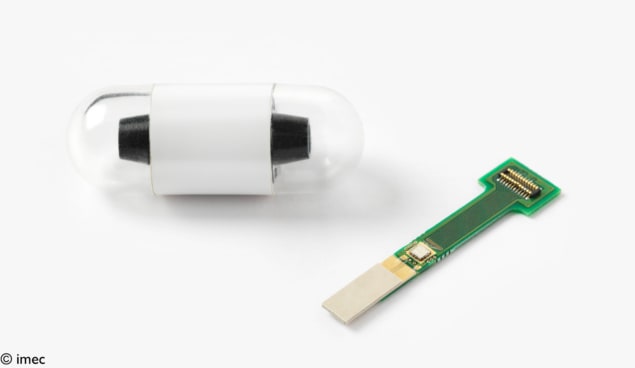
Researchers at Imec, a Leuven, Belgium-based centre for nanoelectronics and digital technologies, have developed a wireless receiver and transmitter small enough to fit inside a millimetre-scale capsule. The transceiver, which was presented at the International Solid-State Circuits conference in San Francisco, US, last month, is 1/30th the size of today’s state-of-the-art systems and could be used in a broad range of so-called “ingestibles” – sensors that monitor health conditions from inside the human body.
Like their external, wearable cousins, ingestible sensors are designed to measure and track health parameters over a period of time. Unlike them, however, ingestibles need to be able to transmit data autonomously to a receiver station outside the body. “The development of such devices brings along a specific set of challenges,” says Imec’s Christian Bachmann. “They have to be extremely small, consume very little power and be able to connect wirelessly.”
A miniaturization revolution
Bachmann, who serves as programme manager for the Sensitive Networks project at Imec’s laboratory in Eindhoven, Netherlands, explains that these goals are only achievable thanks to an ongoing “miniaturization revolution” in nanoelectronics. This revolution has enabled researchers to develop smart, small and lightweight devices that combine minimal power consumption with maximal patient comfort.
Imec’s wireless transceiver occupies a volume of less than 55 mm³, with areas of 3.5 and 15 mm2 on its sides. It supports transmissions at the medical 400MHz frequency band and contains an on-chip tuneable antenna. According to the Imec team, the most significant achievement is that the module does not require a crystal-based oscillator. Such oscillators are commonly used to precisely stabilize the frequency of radio signals and network protocol timing, but the Imec researchers instead created an on-chip mechanism that, in effect, uses the wireless network to calibrate itself. The lack of an off-chip crystal device made it possible to achieve the extremely small “form factor” needed for an ingestible.
According to Bachmann, on-chip tuning for the miniaturized antenna does more than just guarantee reliable data transmission. It also offers a large flexibility in impedance tuning – meaning that it works over a wide range of impedances in the body, equivalent to a filled and empty stomach. “We foresaw a tuneable impedance that can ‘tune’ itself to conditions seen in the digestive tract, so that the transceiver always makes a reliable link,” he says.
A range of uses
While ingestible devices are in their infancy, their potential benefits are considerable. As well as helping to monitor digestive processes and diagnose gastrointestinal diseases, ingestibles could also replace procedures like endoscopic inspections and stool sample analyses – which can be very uncomfortable and provide only one-time observations. Bachmann says the Imec transceiver has several potential use cases, including ingestibles designed to monitor health, nutrition or biomarkers that indicate the presence of disease. However, he cautions that clinical applications will require a further integration of electronics at the nano level.
“For the moment, there are some camera-integrated pills that can be used to study the digestive tract,” he says. “But these pills are still quite big today.” More advanced applications will probably arise as early demonstrators in the healthcare domain. Apart from cameras, ingestibles could also carry other sensors, which – like the transceivers – will need miniature batteries capable of powering them for several weeks.
Despite these obstacles, Giovanni Traverso, who studies ingestibles and implantable robotics at the Massachusetts Institute of Technology in the US, calls the Imec device “a welcome contribution to the field”. Traverso, who was not involved in the Imec project, adds that a smaller transceiver “certainly boosts the miniaturization of ingestibles” by making more room for other components such as sensors and batteries. “It’s key to make the devices smaller and smaller, as this maximizes the safety while transiting the gastrointestinal tract,” he says.

Ingestible device could help diagnose disease
The end result
That raises an important question: what happens after an ingestible has done its job? Does it just follow the natural way out of the body? Bachmann’s response is that Imec is currently exploring ways of fixing ingestible sensors at certain locations along the gastrointestinal tract. “This would enable longer recordings in specific places of interest and keep patients comfortably outside the hospital while their health data is collected and sent in real time to a doctor,” he says.
Traverso notes that this question is particularly important in his work, which focuses on using ingestibles for drug delivery. For this application, it may be important to keep ingestibles in place for days or even weeks. “We’ve made a lot of progress during the past five years, keeping devices in place in the stomach or in the gastrointestinal tract,” he says. For example, a device could be swallowed as a pill, unfold in the stomach, and then dissolve in the acid environment once it has delivered the required drugs.



